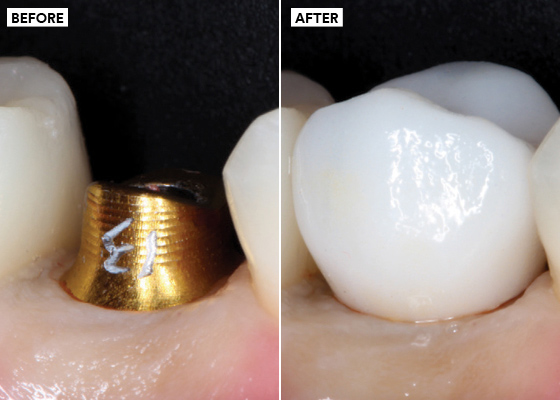Teilnahmebedingungen für das Gewinnspiel “Brain Boost Event 2025 – Gewinne 2x Teilnahmeplätze für dich und deinen Lieblingskollegen in Seefeld”
Teilnahmebedingungen:


You have a lot of options to treat missing teeth – but what about cemented implant restorations? Take a closer look at a great option to fill the gaps.
Dental professionals know that, regardless of cause, missing teeth can affect patients’ quality of life, from speech and chewing problems to decay and gum disease – not to mention confidence in their appearance. While there are many ways to fill the gaps, let’s take a closer look at one well-known treatment option: cemented implant restorations.
Cemented implant restorations are a proven and viable treatment option for missing teeth, particularly for single units, and in the esthetic zone. They are particularly useful when the implant’s angle calls for a screw access channel through the facial surface of the screw-retained restoration. However, the main concern surrounding cemented implant restorations is the potential for residual cement, which can cause gingival irritation or even peri-implantitis – an inflammatory disease that can lead to bone loss or implant rejection.1 The following steps are designed to help minimize issues related to excess cement.
First, margins should never be more than 1mm subgingival (see “before” photo).2 Laboratory and clinical studies have shown that margins over 1mm increase the risk for retained cement.3 Instead of trying to hide titanium with excessively deep margins, a zirconia abutment is recommended for highly esthetic areas. For all but the flattest ridges, a custom abutment should be used to ensure margins are entirely visible and accessible. In non-esthetic areas, on the other hand, margins can be equi-gingival or supra-gingival.
Second, the amount of cement placed in the restoration should be kept to a minimum. There are various ways to do this, but I prefer to simply inject a small to moderate amount of cement directly from the mixing tip into the crown, and distribute it with a microbrush. During crown placement, a small amount of cement should exude, which helps ensure a complete marginal seal.
In my clinical experience, the RMGI cement (3M™ RelyX™ Luting Plus Resin Modified Glass Ionomer Cement) is relatively easy to clean up after its initial set. The cement should only be removed after it has set, and not while it is in a liquid state. In fact, RelyX™ Luting Plus Cement features a 5-second tack-cure to simplify excess cement removal and cleanup. In addition, the cement’s bright white color is ideal for around implants, as it stands out against natural tissue. Some manufacturers have produced pink “implant cement,” in an attempt to mask residual cement – which is actually the last thing clinicians want! Cements, particularly those used for implant restorations, should be easy to differentiate from the soft tissues.
For modern implant connection designs, screw loosening is rare.4 In fact, studies show that loose screws are few and far between, even up to and beyond 10 years, assuming they were torqued properly.5 As such, the idea of needing an implant cement that allows “retrieval” is passé for single units and short span bridges.
Most instances of needing to retrieve an implant restoration involve porcelain failure (especially with porcelain-fuse-to-metal crown (PFMs)). Fortunately, modern implant connections have demonstrated reliable long-term success, with few loose screws. If a permanently cemented implant restoration does require removal, it usually means complete replacement, which is no different than for crowns and bridges on natural teeth. Accessing a screw on a permanently cemented implant is no harder than endodontic access on a tooth with a crown. Some materials are harder to cut through, but nevertheless manageable for most clinicians.
Some clinicians report using temporary cements for implant restorations. But studies on their use in implants are limited, and in my clinical experience, such cements can be extremely difficult to retrieve when desired – and restorations tend to fall off prematurely. The last thing patients and clinicians want to deal with is a crown or bridge falling off and needing to be re-cemented every few years.
The ideal characteristics for an implant cement are:
How to best replace missing teeth is an important decision for patients and clinicians alike. If you choose cemented implant restoration, select the right cement and follow the advice above, you’ll be one step closer to achieving reliable, long-lasting restorations – and enhancing your patients’ health and self-esteem with beautiful smiles.
Sources

How do you motivate your patients? Discover how caries risk assessments and motivational interviewing tactics can help you connect with…

Caries is a complicated multifactorial disease. In this two-part series, explore how caries risk assessments can help improve evaluation and…